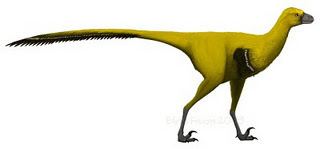Phylum Chordata Clade Maniraptoriformes Rank Genus | ||
 | ||
Similar Dinosaur, Tugulusaurus, Xuanhuaceratops, Theropods, Yixianosaurus | ||
Xinjiangovenator (meaning "Xinjiang hunter") is a genus of coelurosaurian dinosaur of the Valanginian to Albian stages of the Early Cretaceous period.
The remains of Xinjiangovenator were found in the Lianmuqin Formation of Wuerho, Xinjiang, China, and were first described by Dong Zhiming in 1973. Based on holotype IVPP 4024-2, an articulated partial right lower leg, containing the tibia, three pieces of the fibula, the calcaneum and the astragalus, it was originally thought to be another specimen of Phaedrolosaurus. However, Phaedrolosaurus is based only on a non-diagnostic tooth, so the hindlimb bones were given their own genus by Oliver Rauhut and Xu Xing in 2005. The type species is Xinjiangovenator parvus. The generic name is derived from the autonomous region of Xinjiang and Latin venator, "hunter". The specific name parvus means "small" in Latin.
The tibia or shin bone has a length of 312 millimetres. Rauhut and Xu established two unique derived traits, autapomorphies, of the species: the outer condyle at the lower end of the tibia extends further to the back than the tibia top; at the front of the lower end of the tibia a vertical groove is present.
Xinjiangovenator was originally placed as Maniraptora incertae sedis and as possibly closely related to Bagaraatan. A later cladistic analysis recovered a basal position in the Coelurosauria.
